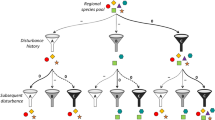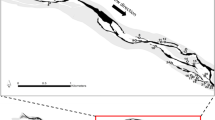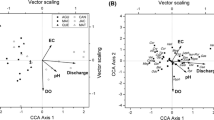Abstract
Both habitat heterogeneity and disturbance can profoundly influence ecological systems at many levels of biological and ecological organization. However, the joint influences of heterogeneity and disturbance on temporal variability in communities have received little attention despite the intense homogenizing influence of human activity. I performed a field manipulation of substrate heterogeneity in a small New England stream, and measured changes in benthic macroinvertebrate communities for 100 days—a period that included both a severe drought and a flood. Generally, community variability decreased with increasing substrate heterogeneity. However, within sampling intervals, this relationship tended to fluctuate through time, apparently tracking changes in hydrology. At the beginning of the experiment, community temporal variability clearly decreased along a gradient of increasing substrate heterogeneity—a result consistent with an observational study performed the previous year. During the subsequent weeks, droughts and flooding created exceptionally high variability in both hydrology and benthic macroinvertebrate community structure resulting in the disappearance of this relationship. However, during the last weeks of the experiment when hydrologic conditions were relatively more stable, the negatively sloped relationship between community temporal variability and habitat heterogeneity reemerged and mimicked relationships observed both early in the experiment and in the previous year’s study. High habitat heterogeneity may promote temporal stability through several mechanisms including stabilization of resources and increased refugia from minor disturbances or predation. However, the results of this experiment suggest that severe disturbance events can create large-scale environmental variability that effectively swamps the influence of habitat heterogeneity, illustrating that a thorough understanding of community temporal variability in natural systems will necessarily consider sources of environmental variability at multiple spatial and temporal scales.



Similar content being viewed by others
References
Barnes, B. & M. L. Roderick, 2004. An ecological framework linking scales across space and time based on self-thinning. Theoretical Population Biology 66: 113–128.
Beisel, J. -N., P. Usseglio-Polatera, S. Thomas & J. -C. Morteteau, 1998. Stream community structure in relation to spatial variation: the influence of mesohabitat characteristics. Hydrobiologia 389: 73–88.
Benton, T. G., J. A. Vickery & J. D. Wilson, 2003. Farmland biodiversity: is habitat heterogeneity the key? Trends in Ecology and Evolution 18: 182–188.
Bergey, E. A., 1999. Crevices as refugia for stream diatoms: effect of crevice size on abraded substrates. Limnology and Oceanography 44: 1522–1529.
Biggs, B. J. F. & R. A. Smith, 2002. Taxonomic richness of stream benthic algae: effects of flood disturbance and nutrients. Limnology and Oceanography 47: 1175–1186.
Brown, B. L., 2003. Spatial heterogeneity reduces temporal variability in stream insect communities. Ecology Letters 6: 316–325.
Caley, M. J. & J. StJohn, 1996. Refuge availability structures assemblages of tropical reef fishes. Journal of Animal Ecology 65: 414–428.
Cardinale, B. J, M. A. Palmer, C. M. Swan, S. S. Brooks & N. L. Poff, 2002. The influence of substrate heterogeneity on biofilm metabolism in a stream ecosystem. Ecology 83: 412–422.
Carey, A. B., 2003. Biocomplexity and restoration of biodiversity in temperate coniferous forest: inducing spatial heterogeneity with variable-density thinning. Forestry 76: 127–136.
Caswell, H., J. E. Cohen, 1991. Communities in patchy environments: a model of disturbance, competition, and heterogeneity. In Kolasa, J. & S. T. A. Pickett (eds), Ecological Heterogeneity. Springer-Verlag, New York.
Collins, S. L., F. Micheli & L. Hartt, 2000. A method to determine rates and patterns of variability in ecological communities. Oikos 91: 285–293.
Cottingham, K. L., B. L. Brown & J. T. Lennon, 2001. Biodiversity may regulate the temporal variability of ecological systems. Ecology Letters 4: 72–85.
Cramer, M. J. & M. R. Willig, 2005. Habitat heterogeneity, species diversity and null models. Oikos 108: 209–218.
Crowder, L. B. & W. E. Cooper, 1982. Habitat structural complexity and the interaction between bluegills and their prey. Ecology 63: 1802–1813.
Dobson, A. P., A. D. Bradshaw & A. J. M. Baker, 1997. Hopes for the future: restoration ecology and conservation biology. Science 277: 515–522.
Finke, D. L. & R. F. Denno, 2002. Intraguild predation diminished in complex-structured vegetation: implications for prey suppression. Ecology 83: 643–652.
Friedenberg, N. A., 2003. Determinism in a transient assemblage: the roles of dispersal and local competition. American Naturalist 162: 586–596.
Gotelli, N. J. & R. K. Colwell, 2001. Quantifying biodiversity: procedures and pitfalls in the measurement and comparison of species richness. Ecology Letters 4: 379–391.
Grimm, V., E. Schmidt & C. Wissel, 1992. On the application of stability concepts in ecology. Ecological Modelling 63: 143–161.
Halaj, J., A. B. Cady & G. W. Uetz, 2000. Modular habitat refugia enhance generalist predators and lower plant damage in soybeans. Environmental Entomology 29: 383–393.
Hansen, R. A., 2000. Effects of habitat complexity and composition on a diverse litter microarthropod assemblage. Ecology 81: 1120–1132.
Herrnkind, W. F., M. J. Butler IV, J. H. Hunt & M. Childress, 1997. Role of physical refugia: implications from a mass sponge die-off in a lobster nursery in Florida. Marine and Freshwater Research 48: 759–769.
Hildrew, A. G. & C. R. Townsend, 1977. The influence of substrate on the functional response of Plectrocnemia conspersa (Curtis) larvae (Trichoptera: Polycentropodidae). Oecologia 31: 21–26.
Holomuzki, J. R. & B. J. F. Biggs, 1999. Distributional responses to flow disturbance by a stream-dwelling snail. Oikos 87: 36–47.
Holomuzki, J. R. & B. J. F. Biggs, 2000. Taxon-specific responses to high-flow disturbances in streams: implications for population persistence. Journal of the North American Benthological Society 19: 670–679.
Holomuzki, J. R. & B. J. F. Biggs, 2003. Sediment texture mediates high-flow effects on lotic macroinvertebrates. Journal of the North Amercian Benthological Society 22: 542–553.
Holt, R. D., 1984. Spatial heterogeneity, indirect interactions, and the coexistence of prey species. The American Naturalist 124: 37–406.
Holt, R. D. & M. P. Hassell, 1993. Environmental heterogeneity and the stability of host-parasitoid interactions. Journal of Animal Ecology 62: 89–100.
Holyoak, M., M. A. Leibold & R. D. Holt, 2005. Metacommunities: Spatial Dynamics and Ecological Communities. University of Chicago Press, Chicago and London, 513pp.
Horner-Devine, M. C. & K. M. Carney & B. J. M. Bohannan, 2004. An ecological perspective on bacterial biodiversity. Proceedings of the Royal Society of London Series B-Biological Sciences 271: 113–122.
Horvath, T. G., 2004. Retention of particulate matter by macrophytes in a first-order stream. Aquatic Botany 78: 27–36.
Hutchinson, G. E., 1961. The paradox of the plankton. The American Naturalist 95: 137–145.
Jakalaniemi, A., J. Tuomi, P. Siikamaki & A. Kilpia, 2005. Colonization-extinction and patch dynamics of the perennial riparian plant Silene tatarica. Journal of Ecology 93: 1–11.
Kie, J. G., T. Bowyer, M. C. Nicholson, B. B. Boroski & E. R. Loft, 2002. Landscape heterogeneity at differing scales: Effects on spatial distribution of mule deer. Ecology 83: 530–544.
Lake, P. S., 2003. Ecological effects of perturbation by drought in flowing waters. Freshwater Biology 48: 1161–1172.
Lancaster, J., 1999. Small scale movements of lotic macroinvertebrates with variations in flow. Freshwater Biology 41: 605–619.
Lancaster, J. & L. R. Belyea, 1997. Nested hierarchies and scale-dependence of mechanisms of flow refugium use. Journal of the North American Benthological Society 16: 221–238.
Lester, P. J., H. M. A. Thistlewood & R. Harmsen, 1998. The effects of refuge size and number on acarine predator-prey dynamics in a pesticide-disturbed apple orchard. Journal of Applied Ecology 35: 323–331.
Lewis, D. B. & L. A. Eby, 2002. Spatially heterogeneous refugia and predation risk in intertidal salt marshes. Oikos 96: 119–129.
Li, H. & J. F. Reynolds, 1994. A simulation experiment to quantify spatial heterogeneity in categorical maps. Ecology 75: 2446–2455.
Matthaei, C. D., K. A. Peacock & C. R. Townsend, 1999. Patchy surface stone movement during disturbance in a New Zealand stream and its potential significance for the fauna. Limnology and Oceanography 44: 1091–1102.
Micheli, F., K. L. Cottingham, J. Bascompte, O. N. Bjornstad, G. L. Eckert, J. M. Fischer, T. H. Keitt, B. E. Kendall, J. L. Klug & J. A. Rusak, 1999. The dual nature of community variability. Oikos 85: 161–169.
Minshall, G. W., 1984. Aquatic insect-substratum relationships. In Resh, V. H. & D. M. Rosenberg (eds), The Ecology of Aquatic Insects. CBS Educational and Professional Publishing, New York, 358–400.
Naeem, S. & S. Li, 1997. Biodiversity enhances ecosystem reliability. Nature 390: 507–509.
Neter, J., M. H. Kutner, C. J. Nachtsheim & W. Wasserman, 1996, Applied Linear Statistical Models. McGraw-Hill, Boston, 1408 pp.
Odum, E. P., J. T. Finn & E. H. Franz, 1979. Perturbation theory and the subsidy-stress gradient. Bioscience 29: 349–352.
Palmer, M. A., R. F. Ambrose & N. L. Poff, 1997. Ecological theory and community restoration ecology. Restoration Ecology 5: 291–300.
Pianka, E. R., 1966. Latitudinal gradients in species diversity: a review of concepts. The American Naturalist 100: 33–46.
Pickett, S. T. A. & P. S. White, 1985. The Ecology of Natural Disturbance and Patch Dynamics. Academic Press, Inc., Orlando.
Poff, N. L. & J. V. Ward, 1990. Physical habitat template of lotic systems: recovery in the context of historical pattern of spatiotemporal heterogeneity. Environmental Management 14: 629–645.
Resh, V. H., A. V. Brown, A. P. Covich, M. E. Gurtz, H. W. Li, G. W. Minshall, S. R. Reice, A. L. Sheldon, J. B. Wallace & R. C. Wissmaar, 1988. The role of disturbance in stream ecology. Journal of the North American Benthological Society 7: 433–455.
Scognamillo, D., I. E. Maxit, M. Sunquist & J. Polisar, 2003. Coexistence of jaguar (Panthera onca) and puma (Puma concolor) in a mosaic landscape in the Venezuelan llanos. Journal of Zoology, London 259: 269–279.
Silver, P., J. K. Cooper, M. A. Palmer & E. J. Davis, 2000. The arrangement of resources in patchy landscapes: effects on distribution, survival, and resource acquisition of chironomids. Oecologia 124: 216–224.
Stewart, T. W., T. L. Shumaker & T. A. Radzio, 2003. Linear and nonlinear effects of habitat structure on composition and abundances in the macroinvertebrate community of a large river. American Midlands Naturalist 149: 293–305.
Suren, A. M., 1992. Enhancement of invertebrate food resources by bryophytes in New Zealand alpine headwater streams. New Zealand Journal of Marine and Freshwater Biology 26: 229–239.
Tews, J., U. Brose, V. Grimm, K. Tielborger, M. C. Wichmann, M. Schwager & F. Jeltsch, 2004. Animal species diversity driven by habitat heterogeneity/diversity: the importance of keystone structures. Journal of Biogeography 31: 79–92.
Wallace, J. B. & J. W. Grubaugh, 1996. Transport and storage of FPOM. In Hauer, F. R. & G. A. Lamberti (eds), Methods in Stream Ecology. Academic Press, San Diego, 191–215.
Warfe, D. M. & L. A. Barmuta, 2004. Habitat structural complexity mediates the foraging success of multiple predator species. Oecologia 141: 171–178.
Wolman, M. G., 1954. A method of sampling coarse river-bed material. Transactions of the American Geophysical Union 35: 951–956.
Acknowledgements
This work was supported in part by NSF grant DEB-0108474 and the Cramer fund of the Department of Biological Sciences at Dartmouth College. Thanks to Kathy Cottingham, Joe Holomuzki, Matt Ayres, Mark McPeek, Jay Lennon, Ryan Thum, Mathew Leibold, The Scientist Formerly Known as Rob Creed., and Nicolas Louille for advice and assistance during the course of this work. L. M. Bini, and three anonymous reviewers provided valuable comments on earlier versions of the manuscript. Special thanks to Laura Ammons for devoted help in all aspects of this research.
Author information
Authors and Affiliations
Corresponding author
Additional information
Handling editor: L. M. Bini
Rights and permissions
About this article
Cite this article
Brown, B.L. Habitat heterogeneity and disturbance influence patterns of community temporal variability in a small temperate stream. Hydrobiologia 586, 93–106 (2007). https://doi.org/10.1007/s10750-006-0531-3
Received:
Revised:
Accepted:
Published:
Issue Date:
DOI: https://doi.org/10.1007/s10750-006-0531-3




